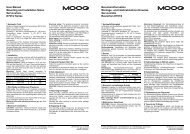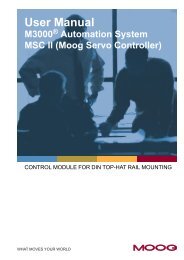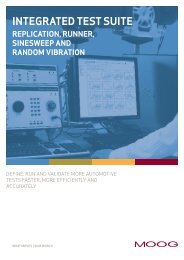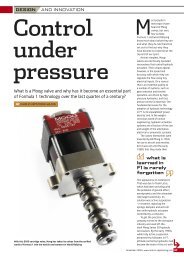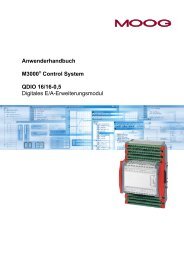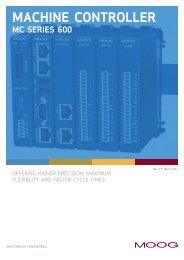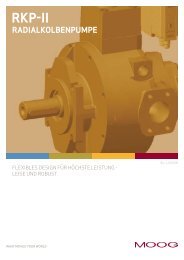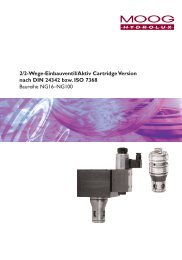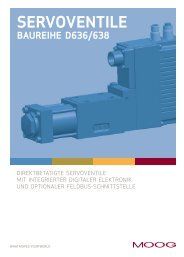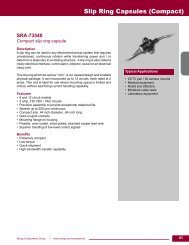brushless servomotor fastact g g400 series - Moog Inc
brushless servomotor fastact g g400 series - Moog Inc
brushless servomotor fastact g g400 series - Moog Inc
You also want an ePaper? Increase the reach of your titles
YUMPU automatically turns print PDFs into web optimized ePapers that Google loves.
OVERVIEW <strong>Moog</strong> | FASTACT G/G400 <strong>series</strong><br />
<strong>Moog</strong> Brushless Technology<br />
For over two decades, the name <strong>Moog</strong> has been associated<br />
with <strong>brushless</strong> servo motors and drives offering the<br />
highest dynamics, power density and reliability. The servo<br />
motors and drives are designed as a system to deliver<br />
superior servo performance. <strong>Moog</strong> offers a broad range of<br />
standard servo motors and drives as well as custom solutions<br />
to meet your unique application requirements. <strong>Moog</strong><br />
<strong>brushless</strong> servo motors and drives are found on a variety of<br />
applications; especially where dynamics, compact size and<br />
reliability are important.<br />
G400 Series Brushless Servomotors<br />
<strong>Moog</strong>’s G400 Series motors are electronically commutated<br />
synchronous AC motors with permanent magnet field<br />
excitation.<br />
G400 Series motors are designed for highly dynamic servo<br />
applications where positioning times of 30 msec or less<br />
are often the norm. The G400 Series offers one of the<br />
industry’s widest power ranges with standard models<br />
available at continuous torque ratings from 0. 5 to 76.6<br />
Nm ( .33 to 673 lb-in ). The modular design is supported by<br />
a variety of options with <strong>Moog</strong>’s application staff capable<br />
of supplying fully customized solutions. All <strong>Moog</strong> servo<br />
motors are manufactured in-house and the use of tight<br />
machining tolerances, precision balancing and thorough<br />
production testing guarantee a long service life.<br />
Ordering information and motor nameplate<br />
To order a motor, choose the various Type options by filling<br />
in the boxcar on the inside back page of the catalog. <strong>Moog</strong><br />
sales department will provide the corresponding Model<br />
number suitable for the order. Both model number and<br />
boxcar (Model and Type respectively, as in picture) will be<br />
present on the motor nameplate. The Type field may vary<br />
for motors released prior to June 2008.<br />
Version .0 | 0/2008<br />
<strong>Moog</strong> Motor Performance Characteristics<br />
In collaborating with a variety of industrial machine designers,<br />
<strong>Moog</strong> realizes what a critical role the application<br />
sizing process plays in overall machine design. With global<br />
competition forcing designers to do more with less, there<br />
is an ever-increasing need to avoid unnecessary margin<br />
and ”size” exactly to your application needs. It is for these<br />
reasons that <strong>Moog</strong> specifies motor performance characteristics<br />
in a manner that makes them practical for designing<br />
your system. Motor characteristics are specified under the<br />
same environmental conditions in which they will be used,<br />
with notes clearly articulating the operating conditions.<br />
The motor performance characteristic contains three<br />
elements.<br />
The first element is the continuous torque curve. This curve<br />
illustrates the motor torque available at 00% duty cycle<br />
under the following conditions:<br />
• operation in still air with ambient temperatures up to<br />
40°C<br />
• winding temperature at 0°C over ambient for resolver<br />
feedback motors<br />
• motor front flange attached to a steel mounting plate<br />
measuring 300 x 300 x 2 mm<br />
The second element is the peak torque curve. This curve<br />
reflects the motor torque available with a 10% duty cycle<br />
( out of 0 seconds). It is based on years of practical<br />
industry experience and is useful for typical servo applications.<br />
The third element is the motor Kt characteristic. The motor<br />
Kt characteristic depicts stator saturation at various operating<br />
points and can be used to optimize sizing in low duty<br />
cycle applications. G400 motors can deliver a low duty<br />
cycle “impulse torque” which is typically 20–30% more<br />
than rated peak torque. While motors can be operated<br />
reliably at this operating point it is recommended that a<br />
member of <strong>Moog</strong>’s application team review the application<br />
to ensure thermal restrictions are not violated.<br />
1 Continuous torque with<br />
1 12<br />
convection cooling<br />
3 2 Peak torque<br />
3 Motor Kt<br />
2





